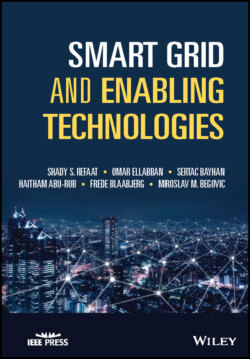Читать книгу Smart Grid and Enabling Technologies - Frede Blaabjerg - Страница 45
1.8.1 The Necessity for Paradigm Shift to SG
ОглавлениеMaintaining economic growth and improving the quality of human life are reliant on the availability of affordable and reliable electricity. Up to now, conventional grids function in almost the same way as those of 130 years ago, i.e. power flows in a single direction across the grid, from the central power plants to the customers. The reliability is maintained by conserving the excess capacity, which is inefficient, uneconomic, and environmentally unfriendly. Current grid topologies cannot be used with the distributed renewable energy sources and two‐directional power flow. The alternating nature of renewable energy sources creates additional challenges. The aging grid also faces new problems due to increased demand, and nonlinear loads. Such a grid experiences an inability when the demand for power delivery and consumption boosts, which has happened frequently worldwide in recent years. The main reason that acts on the decrease of the traditional power grid's reliability is the lack of information exchange [54]. The current grid is of limited ability to react quickly to handle congestion, instability, and power quality challenges. The inflexibility of the existing grid cannot support the high integration of renewable energy. These limitations can lead to blackouts, equipment outages, and unscheduled downtime. Approximately 90% of all power outages and disturbances have their origins in the distribution network, therefore, transforming to the SG paradigm ensures a significant improvement of the grid's reliability. Furthermore, electric utility customers currently have a passive role; they have no access to the real‐time consumption and pricing information that allow them actively participate within the power grids and optimize their energy usage and bills during peak and off‐peak times. The two‐way communication and power flow within the SG allow for effective energy control and energy management. This feature also allows achievement of both environmental and economic sustainability.
Figure 1.17 The difference between the conventional power grid and smart grid structure.
Table 1.1 A detailed comparison between conventional power grids and smart grids.
| Characteristics | Traditional grid | Smart Grid |
|---|---|---|
| Technology | ElectromechanicalMechanical devices electricity operatedNo communication between devicesLittle internal regulation | DigitalDigital devicesIncreased communication between devicesRemote control and self‐regulation |
| Flow of power and communication | One wayPower flow starts from the main plant using traditional energy structure to the customer | Two wayPower flow goes to and from various grid users |
| Generation | Centralized | Distributed |
| Fault location | Difficult to determine | Can be determined remotely as well as predicted |
| Monitoring | Manual | Self‐ monitoring |
| Equipment failure | System responds to deal with post failure and blackout incidents | Adaptive and can be isolated and automatically reconnected. |
| Control | Limited control system | Pervasive control system |
| Operation and maintenance | Manually equipment checks | Remotely monitor equipment |
In summary, transforming to SG paradigm will help in the wide‐scale integration of energy sources, enhancing network reliability, and improving power quality and load profile.
